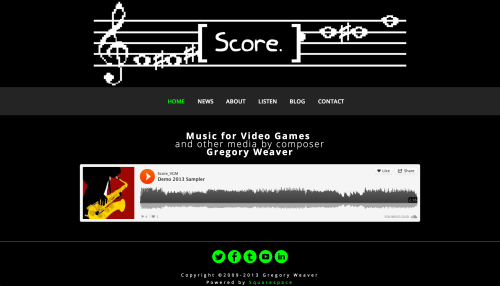
As I mentioned in my last blog post, I decided to participate in a month-long Game Jam sponsored by the Baltimore Indie Games group. The theme of this jam was “Random Name Generator,” and thus each group was tasked to click a button to receive a name, and if they liked the name, make a game out of what they were given. My group decided to generate about ten names we liked, which we voted down to three, which we voted down to one: “German Whale of Mystery.”
Before I get into the details of the game, my team consisted of my friends Stephen and Andrew, a group of three computer science students from American University, and me. Stephen was charge of the art, I did the music and sound, and the others worked on programming. Some of you may be thinking that a six-person group is quite large for a game jam, but it worked for us because our programmers didn’t have a ton of experience in game design. It ended up working well for us!
As for the game itself, German Whale of Mystery is a stealth platformer set in World War II, where a whale is infiltrating the Nazis’ base to defeat (who else but) Hitler. In order to successfully reach Hitler, the whale must avoid guards by hiding behind objects and donning costumes to move from level to level in the Nazi stronghold. If a guard catches you, you meet your end in gruesome fashion.
If you’d like to play our game, do so here! Be sure to read the description at the bottom of that page for the controls.
Focusing solely on the music, I ended up creating five tracks for this game:
1. The Duke of Whales
“The Duke” was my first track for the game both in concept and in creation. If you played the game, you probably thought it strange that the level theme had such a definite ending—there’s a reason for that strangeness. This tune was originally intended to serve as its title theme, but after seeing the animation of the whale moving, I swapped it with “Blubber Blues,” which you’ll hear next.
My original concept was that, since we were doing a game set in World War II, I should write a big band piece. In order to represent the whale, I decided to make the bari sax the featured instrument. Now, I wouldn’t say that the tune is a period piece by any means – it wasn’t done particularly in the style of big band tunes from the ‘40s – but it gets the point across.
This tune, like most of the others, was written in Finale and features no production edits. Not only did I want to keep the tunes sounding “lo-fi” due to the game’s art style, it was in my best interest in terms of time to keep the production value low.
2. Blubber Blues
Though the title suggests that it might be a traditional blues, it’s really just a blues-tinged piece. As I mentioned above, I wrote this one as a level theme, thinking it should be good sneaking music. It turned out, however, that the whale walked quickly and with confidence, so the tune no longer fit. Luckily, it went well with the art on the title screen.
3. Folk Whale
The first costume that the whale encounters is the lederhosen garb. I set out to write a polka and came up with this, which is more of a polka-esque romp that captures the utter silliness of the game.
4. Scotch and Ginger Whale
The second costume we came up with was a fancy suit, complete with top hat and monocle. I went with a harpsichord on this one as opposed to something more complex like a string quartet because I needed to bust something out relatively quickly. It wasn’t necessarily “fast” to write a solo piano piece, but it did save me some time. To extend the tune’s length without writing all new sections, I wrote an alternate left hand part and sandwiched it between two instances of my original idea.
5. Fin (Game Over)
This tune turned out to work well for both the “You Died” and the “You Win” screens. I had written some goofy lyrics for it and thought to record myself singing in four-part harmony, but didn’t have the time, unfortunately. I spruced this one up in Logic because the Finale vocal samples were just too horrible and the program’s mix wasn’t passable.
______________________________________________________________________________________________________________________________
There you have it! I’m going to work on cleaning up these tunes a little bit in Logic so that I can be prouder to have them up on my website, but otherwise, I’m happy with the way they – and the game – turned out. I can’t wait for my next game jam challenge!













